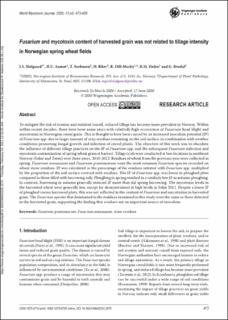| dc.contributor.author | Hofgaard, Ingerd Skow | |
| dc.contributor.author | Aamot, Heidi Udnes | |
| dc.contributor.author | Seehusen, Till | |
| dc.contributor.author | Riley, Hugh | |
| dc.contributor.author | Dill-Macky, Ruth | |
| dc.contributor.author | Holen, Børge | |
| dc.contributor.author | Brodal, Guro | |
| dc.date.accessioned | 2021-02-04T18:26:59Z | |
| dc.date.available | 2021-02-04T18:26:59Z | |
| dc.date.created | 2020-11-25T15:32:32Z | |
| dc.date.issued | 2020-11-09 | |
| dc.identifier.citation | World Mycotoxin Journal. 2020, 13 (4), 473-486. | en_US |
| dc.identifier.issn | 1875-0710 | |
| dc.identifier.uri | https://hdl.handle.net/11250/2726283 | |
| dc.description.abstract | To mitigate the risk of erosion and nutrient runoff, reduced tillage has become more prevalent in Norway. Within within recent decades, there have been some years with relatively high occurrence of Fusarium head blight and mycotoxins in Norwegian cereal grain. This is thought to have been caused by an increased inoculum potential (IP) of Fusarium spp. due to larger amount of crop residues remaining on the soil surface, in combination with weather conditions promoting fungal growth and infection of cereal plants. The objective of this work was to elucidate the influence of different tillage practices on the IP of Fusarium spp. and the subsequent Fusarium-infection and mycotoxin contamination of spring wheat grain at harvest. Tillage trials were conducted at two locations in southeast Norway (Solør and Toten) over three years, 2010-2012. Residues of wheat from the previous year were collected in spring. Fusarium avenaceum and Fusarium graminearum were the most common Fusarium species recorded on wheat straw residues. IP was calculated as the percentage of the residues infested with Fusarium spp. multiplied by the proportion of the soil surface covered with residues. The IP of Fusarium spp. was lower in ploughed plots compared to those tilled with harrowing only. Ploughing in spring resulted in a similarly low IP as autumn ploughing. In contrast, harrowing in autumn generally reduced IP more than did spring harrowing. The mycotoxin levels in the harvested wheat were generally low, except for deoxynivalenol at high levels in Solør 2011. Despite a lower IP of ploughed versus harrowed plots, this was not reflected in the content of Fusarium and mycotoxins in harvested grain. The Fusarium species that dominated in the residues examined in this study were the same as those detected in the harvested grain, supporting the finding that residues are an important source of inoculum. | en_US |
| dc.language.iso | eng | en_US |
| dc.publisher | Wageningen Academic Publishers | en_US |
| dc.rights | Navngivelse-Ikkekommersiell-DelPåSammeVilkår 4.0 Internasjonal | * |
| dc.rights.uri | http://creativecommons.org/licenses/by-nc-sa/4.0/deed.no | * |
| dc.subject | Fusarium | en_US |
| dc.subject | Fusarium | en_US |
| dc.subject | Aksfusariose | en_US |
| dc.subject | Fusarium head blight | en_US |
| dc.subject | Mykotoksiner | en_US |
| dc.subject | Mycotoxins | en_US |
| dc.title | Fusarium and mycotoxin content of harvested grain was not related to tillage intensity in Norwegian spring wheat fields | en_US |
| dc.type | Peer reviewed | en_US |
| dc.type | Journal article | en_US |
| dc.description.version | publishedVersion | en_US |
| dc.rights.holder | © 2020 Wageningen Academic Publishers | en_US |
| dc.subject.nsi | VDP::Planteforedling, hagebruk, plantevern, plantepatologi: 911 | en_US |
| dc.subject.nsi | VDP::Plant breeding, horticulture, plant protection, plant pathology: 911 | en_US |
| dc.source.pagenumber | 473-486 | en_US |
| dc.source.volume | 13 | en_US |
| dc.source.journal | World Mycotoxin Journal | en_US |
| dc.source.issue | 4 | en_US |
| dc.identifier.doi | 10.3920/WMJ2020.2575 | |
| dc.identifier.cristin | 1852367 | |
| dc.relation.project | Forskningsmidlene for jordbruk og matindustri: 199412 | en_US |
| dc.relation.project | Norges forskningsråd: 199412 | en_US |
| cristin.ispublished | true | |
| cristin.fulltext | original | |
| cristin.qualitycode | 1 | |

